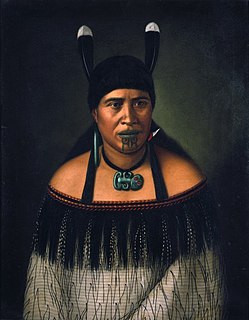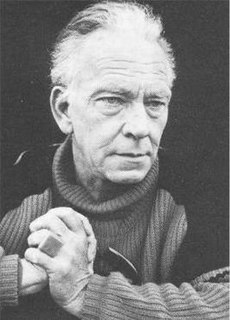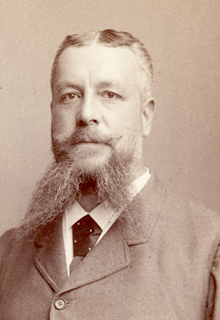The Auckland War Memorial Museum Tāmaki Paenga Hira is one of New Zealand's most important museums and war memorials. Its collections concentrate on New Zealand history, natural history, and military history. The present museum building was constructed in the 1920s in the neo-classicist style, and sits on a grassed plinth in the Auckland Domain, a large public park close to the Auckland CBD.

Charles Frederick Goldie was a New Zealand artist, best known for his portrayal of Māori dignitaries.

Tā moko is the permanent marking or "tattoo" as traditionally practised by Māori, the indigenous people of New Zealand. It is one of the five main Polynesian tattoo styles.

Gottfried Lindauer was a Bohemian and New Zealand artist famous for his portraits, including many of Māori people.
Michael "Michel" Cliff Tuffery is a New Zealand artist of Samoan, Tahitian and Cook Islands descent. He is one of New Zealand's most well known artists and his work is held in many art collections in New Zealand and around the world.

New Zealand art consists of the visual and plastic arts originating from New Zealand. It may come from different traditions: indigenous Māori art, that of the early European settlers, and later immigrants from Pacific, Asian, and European countries.

Theodorus Johannes Schoon was a New Zealand artist, photographer and carver of Dutch descent.

Major General Horatio Gordon Robley was a British soldier who fought in colonial wars in New Zealand, Mauritius, South Africa, and Sri Lanka. He made drawings of Māori people and life Māori culture and collected some Māori items.

Mokomokai, or Toi moko, are the preserved heads of Māori, the indigenous people of New Zealand, where the faces have been decorated by tā moko tattooing. They became valuable trade items during the Musket Wars of the early 19th century.

The Schildergasse is a shopping street in central Cologne, Germany. With 13,000 people passing through it every hour, it is the busiest shopping street in Europe, according to a 2008 survey by GfK. The Schildergasse is a designated pedestrian zone and stretches for about 500 meters from the Hohe Straße at its eastern end to the Neumarkt at the western end.

St. Cecilia's Church is one of the twelve Romanesque churches in Cologne’s old city, maintained by the Foundation of Romanesque Churches in Cologne. The present building, little changed since its inception, dates from 1130-60. Since 1956, the church has been the home of the Schnütgen Museum for medieval art.
Wayne Youle is a New Zealand artist of Ngapuhi, Ngati Whakaeke and Ngati Pakeha descent. His bicultural heritage is reflected in his work, addressing issues of identity, race and the commodification of cultural symbols. He often uses humour to make his point. Youle's work is held in national museums and public galleries. He lives and works in Amberley, New Zealand.

Ngahuia Te Awekotuku is a New Zealand academic specialising in Māori cultural issues and a lesbian activist. In 1972, she was famously denied a visa to visit the United States on the basis of her sexuality.
Galerie Smend is a gallery in Cologne, Germany showing textile art. The gallery was founded in 1973 and run by Rudolf G. Smend until today.
Dagmar Vaikalafi Dyck is a New Zealand artist of Tongan and German descent. Dyck's prints and paintings are often inspired by her cultural heritage and explore textile practices of Tonga. In 2012, Dyck was co-curator of No'o fakataha, a group exhibition of Tongan artists. Dyck's inspirations come from Tonga’s textiles arts, which includes bark cloth, mats, baskets and clothes.

Wilhelm Joest was a German ethnographer and world traveler.
The Lagos carnival also known as the Fanti or Caretta Carnival of Lagos, is the most prominent in West Africa. The carnival is usually held during the Lagos Black Heritage Festival, a colorful folk festival which holds annually in Lagos. The origins of the carnival dates back to the Lagos colonial period when the Brazilian former slave returnees came back to reside in Lagos in the 19th century. The carnival was re-instated in 2010. The event is usually centered on Lagos Island, filled with troop displays of costumes and various forms of entertainment including music and dancing. The carnival portrays an eclectic mixture of Nigerian, Brazilian and Cuban heritage of the city. The Lagos Carnival is filled with amazing and memorable activities.This festival is one of the most colorful and celebrated cultural festivals in Nigeria and quite notable in Africa generally.
Anna Maria Adele Rautenstrauch, née Joest was a German patron and benefactor. She donated the inherited ethnological collection of her brother Wilhelm Joest, which still forms the basis of the Rautenstrauch-Joest Museum, to the City of Cologne.
Sabelo Mlangeni is a South African photographer living and working in Johannesburg, South Africa. His work is held in the collections of the Art Institute of Chicago, the San Francisco Museum of Modern Art, and the Walther Collection.
The International Inventories Programme(IIP) is an international research and database project for investigating objects pertaining to the cultural heritage of Kenya that are held in cultural institutions like ethnographic museums across the globe. The programme is jointly run by the National Museums of Kenya in Nairobi, the Rautenstrauch-Joest Museum in Cologne and the Weltkulturen Museum in Frankfurt a. M., both in Germany. To establish a direct relation to contemporary cultural activities both in Kenya and in Germany, the multi-disciplinary arts groups The Nest Collective (Kenya) and SHIFT Collective in Germany and France are further members of the IIP. - The programme and its projects are supported by the Goethe-Institut - German cultural centre in Kenya - and the German Federal Cultural Foundation.












